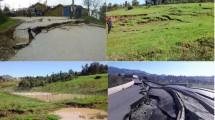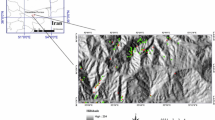Abstract
Landslide susceptibility maps are vital for planning development activities in the mountainous areas in China. The main goal of this study was to produce landslide susceptibility mapping by statistical index (SI) and certainty factor (CF) models for the Shangzhou District of Shangluo City, China. For this purpose, a landslide inventory map with a total of 145 landslide locations was compiled from various sources such as aerial photographs and field surveys, out of which 101 (70 %) were randomly selected for training the models, while the remaining 44 (30 %) were used for validating the models. In this case study, the following landslide conditioning factors were evaluated: slope angle, slope aspect, curvature, elevation, lithology, distance to faults, distance to rivers, distance to roads, precipitation, and peak ground acceleration were considered in this study. The validation of landslide susceptibility maps were carried out using areas under the curve (AUC). From the analysis, it is seen that the CF model with a training accuracy of 70.48 % and predictive accuracy of 68.86 % performs slightly better than SI model (training accuracy, 70.19 %; predictive accuracy, 68.67 %). Overall, both of these two models showed almost similar results. The resultant susceptibility maps can be useful for general land use planning for the study area and other similar areas in the world.






Similar content being viewed by others
References
Akgun A (2012) A comparison of landslide susceptibility maps produced by logistic regression, multi-criteria decision, and likelihood ratio methods: a case study at İzmir, Turkey. Landslides 9:93–106
Ayalew L, Yamagishi H (2005) The application of GIS-based logistic regression for landslide susceptibility mapping in the Kakuda Yahiko Mountains, Central Japan. Geomorphology 65:15–31
Bui DT, Lofman O, Revhaug I, Dick O (2011) Landslide susceptibility analysis in the Hoa Binh province of Vietnam using statistical index and logistic regression. Nat Hazards 59:1413–1444
Cevik E, Topal T (2003) GIS-based landslide susceptibility mapping for a problematic segment of the natural gas pipeline, Hendek (Turkey). Environ Geol 44:949–962
Chen W, Li WP, Hou EK, Zhao Z, Deng ND, Bai HY, Wang DZ (2014) Landslide susceptibility mapping based on GIS and information value model for the Chencang District of Baoji, China. Arab J Geosci 7:4499–4511
Chung CF, Fabbri AG (1998) Three Bayesian prediction models for landslide hazard. In: Buccianti A, Nardi G, Potenza R (eds) Proceedings of International Association for Mathematical Geology 1998 Annual Meeting (IAMG’98), Ischia, Italy, October 1998. pp. 204–211
Devkota KC, Regmi AD, Pourghasemi HR, Yoshida K, Pradhan B, Ryu IC, Dhital MR, Althuwaynee OF (2013) Landslide susceptibility mapping using certainty factor, index of entropy and logistic regression models in GIS and their comparison at Mugling-Narayanghat road section in Nepal Himalaya. Nat Hazards 65:135–165
Einstein HH (1988) Special lecture: landslides risk assessment procedure. In: Proceedings of 5th symposium on landslides, Lausanne, vol 2, pp 1075–1090
Ercanoglu M, Gokceoglu C (2004) Use of fuzzy relation to produce landslide susceptibility map of a landslide prone area (West Black Sea Region, Turkey). Eng Geol 75:229–250
Fell R, Corominas J, Bonnard C, Cascini L, Leroi E, Savage WZ (2008) Guidelines for landslide susceptibility, hazard and risk zoning for land use planning. Eng Geol 102:85–98
Grozavu A, Plescan S, Patriche CV, Margarint MC, Rosca B (2013) Landslide susceptibility assessment: GIS application to a complex mountainous environment. The Carpathians: integrating nature and society towards sustainability, environmental science and engineering, pp 31–44
Guzzetti F (2005) Landslide hazard and risk assessment. PhD Dissertation, Rheinischen Friedrich-Wilhelms-University Bonn, p 389
Kundu S, Saha AK, Sharma DC, Pant CC (2013) Remote sensing and GIS based landslide susceptibility assessment using binary logistic regression model: a case study in the Ganeshganga Watershed, Himalayas. J Indian Soc Remote Sens 41(3):697–709
Lan HX, Zhou CH, Wang LJ, Zhang HY, Li RH (2004) Landslide hazard spatial analysis and prediction using GIS in the Xiaojiang watershed, Yunnan, China. Eng Geol 76:109–128
Nefeslioglu HA, Gokceoglu C, Sonmez H (2008) An assessment on the use of logistic regression and artificial neural networks with different sampling strategies for the preparation of landslide susceptibility maps. Eng Geol 97:171–191
Ozdemir A, Altural T (2013) A comparative study of frequency ratio, weights of evidence and logistic regression methods for landslide susceptibility mapping: Sultan Mountains, SW Turkey. J Asian Earth Sci 64:180–197
Park S, Choi C, Kim B, Kim J (2013) Landslide susceptibility mapping using frequency ratio, analytic hierarchy process, logistic regression, and artificial neural network methods at the Inje area, Korea. Environ Earth Sci 68:1443–1464
Pourghasemi HR, Pradhan B, Gokceoglu C, Mohammadi M, Moradi HR (2012) Application of weights-of-evidence and certainty factor models and their comparison in landslide susceptibility mapping at Haraz watershed, Iran. Arab J Geosci 6:2351–2365
Pourghasemi HR, Moradi HR, Fatemi Aghda SM (2013a) Landslide susceptibility mapping by binary logistic regression, analytical hierarchy process, and statistical index models and assessment of their performances. Nat Hazards 69:749–779
Pourghasemi HR, Pradhan B, Gokceoglu C, Deylami Moezzi K (2013b) A comparative assessment of prediction capabilities of Dempster-Shafer and weights-of-evidence models in landslide susceptibility mapping using GIS. Geomatics Nat Hazards Risk 4(2):93–118
Pourghasemi HR, Pradhan B, Gokceoglu C, Mohammadi M, Moradi HR (2013c) Application of weights-of-evidence and certainty factor models and their comparison in landslide susceptibility mapping at Haraz watershed, Iran. Arab J Geosci 6:2351–2365
Pradhan B (2010) Landslide susceptibility mapping of a catchment area using frequency ratio, fuzzy logic and multivariate logistic regression approaches. J Indian Soc Remote Sens 38(2):301–320
Pradhan B, Oh HJ, Buchroithner M (2010) Weights-of-evidence model applied to landslide susceptibility mapping in a tropical hilly area. Geomatics Nat Hazards Risk 1(3):199–223
Rautela P, Lakhera RC (2000) Landslide risk analysis between Giri and Tons Rivers in Himachal Himalaya (India). Int J Appl Earth Obs Geoinf 2:153–160
Regmi NR, Giardino JR, Vitek JD (2010) Modeling susceptibility to landslides using the weight of evidence approach: Western Colorado, USA. Geomorphology 115:172–187
Regmi AD, Devkota KC, Yoshida K, Pradhan B, Pourghasemi HR, Kumamoto T, Akgun A (2014) Application of frequency ratio, statistical index, and weights-of-evidence models and their comparison in landslide susceptibility mapping in Central Nepal Himalaya. Arab J Geosci 7(2):725–742
Soeters R, van Westen CJ (1996) Slope stability recognition analysis and zonation. In: Turner AK, Schuster RL (eds) Landslides: investigation and mitigation, transportation research board special report 247. National Academy Press, Washington, pp 129–177
Solaimani K, Mousavi SZ, Kavian A (2013) Landslide susceptibility mapping based on frequency ratio and logistic regression models. Arab J Geosci 6:2557–2569
van Westen CJ, Rengers N, Terlien MTJ, Soeters R (1997) Prediction of the occurrence of slope instability phenomena through GIS based hazard zonation. Geol Rundsch 86:404–414
Wang HB, Sassa K (2005) Comparative evaluation of landslide susceptibility in Minamata area, Japan. Environ Geol 47:956–966
Wieczorek GF (1984) Preparing a detailed landslide-inventory map for hazard evaluation and reduction. Assoc Eng Geol Bull 21(3):337–342
Xu C, Xu XW, Dai FC, Saraf AK (2012) Comparison of different models for susceptibility mapping of earthquake triggered landslides related with the 2008 Wenchuan earthquake in China. Comput Geosci 46:317–329
Acknowledgments
The authors want to express their gratitude to everyone who provided assistance for the present study.
Author information
Authors and Affiliations
Corresponding author
Rights and permissions
About this article
Cite this article
Zhao, C., Chen, W., Wang, Q. et al. A comparative study of statistical index and certainty factor models in landslide susceptibility mapping: a case study for the Shangzhou District, Shaanxi Province, China. Arab J Geosci 8, 9079–9088 (2015). https://doi.org/10.1007/s12517-015-1891-7
Received:
Accepted:
Published:
Issue Date:
DOI: https://doi.org/10.1007/s12517-015-1891-7




